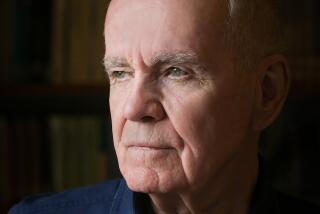Another Selznick harnesses power of the moving picture
On the surface, it sounds like an old-school pre-adolescent storybook: Sensitive orphan lives secretly in Parisian train station, loses an obscure notebook and is launched on an unexpected journey.
Even the book’s shape -- a squat, 3-pound doorstop that would appear more fitting for the collected works of H.G. Wells -- seems like a throwback.
But for all its retro details, “The Invention of Hugo Cabret” is more proof that we’re living in a post-textual age. Author and illustrator Brian Selznick, a distant cousin of legendary film producer David O. Selznick, builds the book more from images than words, turning it into a kind of preteen graphic novel: A dozen or so wordless pages can pass with characters running through the station, walking down streets or flipping through old drawings.
“Hugo Cabret,” which has received rhapsodic reviews, started out as a much shorter and more conventional book. The path from idea to publication took more than a decade, but the book’s reach into other media came, oddly, from its setting in ‘30s France, where sound cinema was still a relatively new and richly unstable medium.
“I watched a lot of movies and thought about how they told their stories,” said Selznick, a wiry 40-year-old who speaks and moves very deliberately, at lunch recently at the Beverly Hilton. “I began to think about telling some of the story visually, so the pictures didn’t just illustrate what was in the text: You have to read the pictures as much as you read the text, like a miniature silent movie.”
In another break with convention, the book’s publisher, Scholastic, is also selling it as a book on disc, with a DVD about the novel’s creation and historical background. Selznick compared it to the commentary track on a DVD movie.
A book told through pictures may sound like a difficult fit as an audio book. But Jennifer Feldman, the publisher of Scholastic’s audio division, thought of another cinematic parallel.
“In the silent movie era, the music helped move the story forward,” she said. “So on the CDs, the sound design takes the place of the book’s pictures. I felt strongly that I wanted the audio book to stand alone, to be a complete experience.”
But in another sense, Selznick said, his book and its appendages are part of a tradition in children’s literature that go back to the first picture book for children in the 1600s. Selznick is fired by more recent innovators -- Maurice Sendak converting nightmares and his characters’ psychology into visual analogs, and Remy Charlip theorizing on the relationship of book pages to doors and portals.
“Children’s literature has always been innovative,” noted Selznick, especially in its use of text and images and in exploiting the physical format of the book. It’s a realization, though, that Selznick was led to reluctantly.
As early as Selznick’s high school days, drawing and painting in central New Jersey, teachers and friends told him he should illustrate children’s books. “Which made me very strongly not want to draw children’s books.”
He thought of books for kids as being sugary sweet and deliberately avoided studying with several of the field’s noted illustrators while attending the Rhode Island School of Design.
But after graduating and developing an interest in storytelling while traveling in Europe, he took a job at Eeyore’s Books for Children on New York’s Upper West Side, where a manager sent Selznick home some nights with a dozen books.
It was reading these, as well as comics and graphic novels, that showed him the form’s possibilities. “I saw that this was this incredible field where people were doing really experimental things
Within two years of starting at the store, he was writing and illustrating his first book, “The Houdini Box,” and was thus saved from a life of designing corporate logos. Today he draws and writes full time and divides his time between Brooklyn and San Diego, where his boyfriend teaches at UC San Diego.
Selznick’s novel, which unfolds slowly -- with as much intricacy as one of the story’s many toys and machines -- tells the tale of Hugo, the 12-year-old orphan who lives secretly, stealing food to stay alive. Early in the book he’s caught by a bitter old man who runs a toy stall, and the boy’s interest in magic, silent film and an old automata that had belonged to his late father propel the narrative forward.
Although the author came upon the subject matter and historical setting a dozen years ago, it took him more than two years to find how they all fit together.
But the book’s well-wrought construction is one of its strengths. As specific as the book’s setting, “Hugo Cabret” has so many iconic, universal elements it could have been written by Joseph Campbell.
“The orphan in children’s literature is one of the classic characters,” Selznick said. “They’re on their own, and there’s this sense of both wanting to find their independence and also wanting to feel safe. There’s that constant struggle for kids growing up, and when we grow up we’re still dealing with that.”
And there’s a repeated use of loss -- of family, of objects, of connections -- as both plot turns and emotional elements in the book. “I think loss is a big part of storytelling, and a big part for me in figuring out why things are important to these kids.”
It’s when Hugo sneaks into a cinema -- with a cute orphan girl, natch -- and develops an interest in “cinemagician” George Melies, that the book’s visual side really opens up. The seminal Melies film “A Trip to the Moon,” for instance, helps drive the plot, and the book includes images from Harold Lloyd’s “Safety Last” and the Lumiere Brothers’ “The Arrival of a Train at La Ciotat.”
Appropriately, “Hugo Cabret’s” most recent leap out of the world of the conventional book is a pending deal to option the book to Warner Bros., with Martin Scorsese as a potential director.
Despite the author’s interest in moving the medium of the book forward, some of his interests -- late Victorian and early 20th century popular culture, for instance -- are positively antique. His first book was about a kid meeting Houdini, and he’s fascinated with Coney Island, old toys and inventions such as the automata and, of course, silent film.
Sometimes people tell him he shouldn’t throw such esoteric historical references at kids who probably don’t catch them.
But to Selznick, the fact that kids don’t know about these things is only more reason to try to put them across. And his editors at Scholastic have told him that anything that interests his protagonist could, if presented properly, interest his young readers. The kids he meets are full of questions about the world of “Hugo Cabret” and its cultural and historical journey.
“If you get kids’ attention, and are respectful of them, they are willing to be patient,” he said.
“They have to know that there’s a payoff. But you don’t have to rush everything.”
More to Read
Sign up for our Book Club newsletter
Get the latest news, events and more from the Los Angeles Times Book Club, and help us get L.A. reading and talking.
You may occasionally receive promotional content from the Los Angeles Times.






